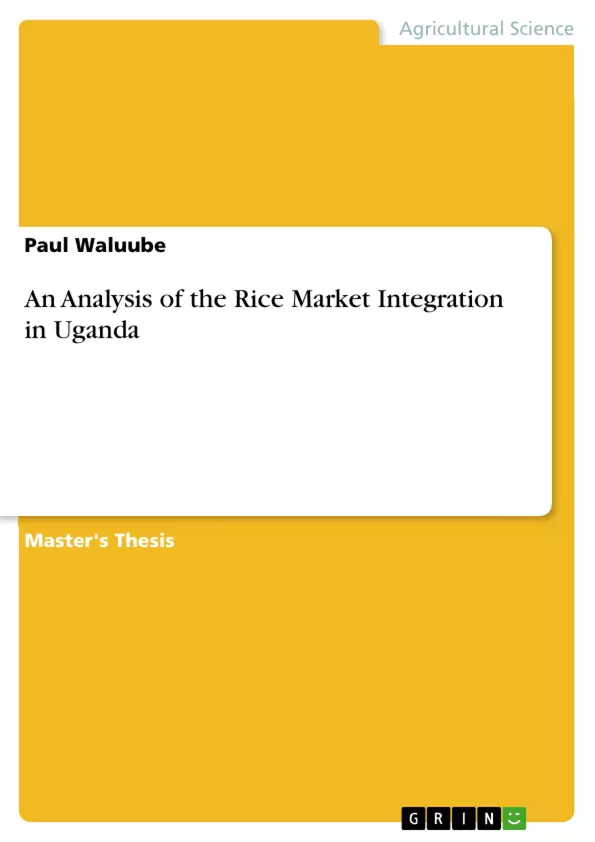It is crucial that formulation of market enhancing policies to improve performance hinges on a better understanding of the local market functioning. Comprehensive market performance is better understood by studying the extent of spatial market integration which in turn is affected by communication factors like telephony growth and extension services within the marketing system. Extension services are important in influencing levels of production and dissemination of trade information of both the inputs to and output from the enterprise. Unfortunately very little was known about how rice price transmission takes place. Given the importance of rice (as a food security crop & source of income) to the rural poor, many organizations have promoted it among rural farmers for improving their welfare, it was imperative that its price movements is studied to inform policy makers & implementers on the status of its spatial market integration.
The primary objective of this study was to evaluate the spatial market integration of rice markets under improving communication infrastructure particularly extension services (NAADS program) and telecommunication industry growth. This study specifically evaluated the degree of spatial market integration and strength of integration using bivariate analysis, Johansen Multiple test, and granger causality relationships. It also determined the impact of NAADS program and telecommunications on spatial rice market integration. Impulse response functions were generated to determine how long shocks in Kampala market can be eliminated in peripheral markets. Weekly prices data from sixteen markets from 2000 to 2006 were divided into three phases; full sample, pre – NAADS expansion and post NAADS program expansion to enable the study to capture the impact of these communication infrastructure.
Results from this study indicate that the markets are spatially integrated and with an incredible speed over the study period. Comparatively, there was more co integration and interdependence of rice markets in the post-NAADS expansion phase than the pre – NAADS expansion phase. A further analysis of the markets using multivariate analytical approach revealed a growing rice economic market constituting eight markets; Kampala, Jinja, Iganga, Lira and Rakai including Gulu, Mbale and Soroti markets with which growth began in the pre-expansion period. [...]
Inhaltsverzeichnis (Table of Contents)
- E: ABSTRACT
- CHAPTER ONE: INTRODUCTION
- 1.1 Background to the study
- 1.2 Statement of the problem
- 1.3 Objectives of the study
- 1.3.1 General Objective
- 1.3.2 Specific Objectives
- 1.4 Research Questions
- 1.5 Justification of the study
- 1.6 Scope of the study
- 1.7 Limitations of the study
- 1.8 Organization of the study
- CHAPTER TWO: LITERATURE REVIEW
- 2.1 Market Integration
- 2.2 Factors Influencing Market Integration
- 2.3 Rice Market Integration in Uganda
- 2.4 The NAADS Program and its Impact on Market Integration
- 2.5 The Role of Telecommunication in Rice Market Integration
- 2.6 Theoretical Framework
- 2.7 Conceptual Framework
- CHAPTER THREE: METHODOLOGY
- 3.1 Study Area
- 3.2 Data Collection Methods
- 3.3 Data Analysis Techniques
- 3.4 Model Specification
- CHAPTER FOUR: RESULTS AND DISCUSSION
- 4.1 Descriptive Statistics
- 4.2 Spatial Market Integration of Rice Markets in Uganda
- 4.3 Impact of NAADS program and Telecommunications on Market Integration
- CHAPTER FIVE: CONCLUSIONS AND RECOMMENDATIONS
Zielsetzung und Themenschwerpunkte (Objectives and Key Themes)
This study aims to assess the spatial market integration of rice markets in Uganda, specifically examining the impact of communication infrastructure improvements, particularly the NAADS program and telecommunications growth. It investigates the degree of market integration and the factors influencing it using various statistical methods.
- Spatial Market Integration of Rice Markets
- Impact of Communication Infrastructure on Market Integration
- Role of the NAADS Program and Telecommunications in Rice Market Integration
- Factors Influencing Rice Market Integration in Uganda
- Policy Implications for Enhancing Rice Market Integration
Zusammenfassung der Kapitel (Chapter Summaries)
- Chapter One: Introduction: This chapter provides the background and context of the study, outlining the problem, objectives, research questions, and justification for the study. It also defines the scope and limitations of the research, as well as the organization of the thesis.
- Chapter Two: Literature Review: This chapter reviews existing literature on market integration, focusing on factors influencing it, particularly in the context of the rice market in Uganda. It examines the NAADS program and telecommunications' role in market integration and presents the theoretical and conceptual frameworks guiding the study.
- Chapter Three: Methodology: This chapter details the research methodology, including the study area, data collection methods, and data analysis techniques employed. It outlines the specific model used to analyze the data and assess market integration.
- Chapter Four: Results and Discussion: This chapter presents the findings of the study, including descriptive statistics, analysis of spatial market integration, and the impact of the NAADS program and telecommunications on market integration. It discusses the implications of the results and provides insights into the dynamics of the rice market in Uganda.
Schlüsselwörter (Keywords)
The study focuses on the spatial market integration of rice in Uganda, examining the impact of communication infrastructure improvements, particularly the NAADS program and telecommunications growth. Key terms include: NAADS program, telecommunications growth, rice, markets, prices, spatial market integration, co-integration, Granger causality, and impulse response functions.
- Quote paper
- Paul Waluube (Author), 2009, An Analysis of the Rice Market Integration in Uganda, Munich, GRIN Verlag, https://www.grin.com/document/340702



